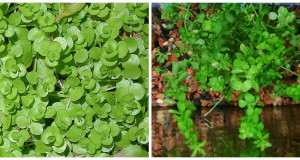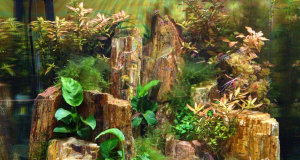Click here to read the first part of this article: A Natural Aquarium: Supplies and Care for the Planted Aquarium – Part 1
Filtration
 Filtration on a planted tank can be minimal, and some experienced Aquatic gardeners even keep them without filtration, but for beginners it’s always good to have a safety net. A submersible or canister filter will be ideal to minimize surface CO2 displacement. Even a simple power filter will work, but the likelihood that you’ll need supplemental CO2 will be increased. Do not use under gravel filtration.
Filtration on a planted tank can be minimal, and some experienced Aquatic gardeners even keep them without filtration, but for beginners it’s always good to have a safety net. A submersible or canister filter will be ideal to minimize surface CO2 displacement. Even a simple power filter will work, but the likelihood that you’ll need supplemental CO2 will be increased. Do not use under gravel filtration.
Substrates
There are lots of substrates that will be suitable for a planted aquarium. Fluorite, being one of the first iron-enhanced, porous clay, plant-specific substrates has these benefits as well as an rather fine grade for good root development. I would say any fine grade, smooth freshwater substrate will do , even mixed with sand to make a finer mix. Substrate is mostly a matter of taste, though roots are delicate and prefer a smoother denser base. Make the gravel bed at least 3-4″ deep.
Temperature
Most plants can tolerate a pretty wide temperature range, but be sure to look at the specific needs of the plants you want to keep to make sure they don’t prefer temps that you won’t be able to maintain. You’ll want to keep the temperature of the tank regulated more for the fish than for the plants, but some species may not thrive in that ideal range. Average temps that keep tropical fish happy will also keep a slew of aquarium plants happy. Do avoid extreme changes in temperature, like strong drafts from windows and doors. Keep the tank in a temperature stable area, and keep an appropriately sized aquarium heater to regulate the temperature, keeping it in the ideal range.
Furniture
 How you decorate a planted tank is entirely up to you. I prefer the natural look, devoid of plastic bridges and castles, but a good piece of gnarly driftwood and a couple of interesting rocks are always welcome. You don’t have to add any embellishments if you don’t want to, but they do add more cover for fish and a focal point in the garden so to speak. Rocks and wood are also useful in terracing. Do be aware before adding any rock in particular as some types of rock and ornamentation may significantly alter PH and other aspects of the chemistry. Beginners may also want to avoid collecting from sources other than aquarium stores and stick to items designed for aquariums to avoid contamination from outside sources.
How you decorate a planted tank is entirely up to you. I prefer the natural look, devoid of plastic bridges and castles, but a good piece of gnarly driftwood and a couple of interesting rocks are always welcome. You don’t have to add any embellishments if you don’t want to, but they do add more cover for fish and a focal point in the garden so to speak. Rocks and wood are also useful in terracing. Do be aware before adding any rock in particular as some types of rock and ornamentation may significantly alter PH and other aspects of the chemistry. Beginners may also want to avoid collecting from sources other than aquarium stores and stick to items designed for aquariums to avoid contamination from outside sources.
Fertilizers
Though many of the necessary nutrients for plants will be provided by the fish and feeding, a heavily planted tank will inevitably need some supplemental fertilizer for continued growth and vigor. Products that provide iron in particular are important, with several other micro-nutrients following closely behind. Some plants may need even more nutrients or root tab fertilizer, but keep a broad range fertilizer on hand to start for regular dosing. CO2 injection is a little more complicated and may not be essential initially. Supplemental CO2 will come into play especially when the system is established and the plants really get going and will probably be necessary once the demand for CO2 from the plants increases. You may want to consider how you’ll provide supplemental CO2 early on if not right away at set-up. For a really impressive set-up and robust and lush growth, it should be included in your plan by any means. You can invest in manufactured regulated injection systems, or with a little research, you can do-it-yourself, but that all depends on you and the needs of your tank.
Reap the Rewards
So, you’re all set-up and ready to add all the fun stuff. The principles of set-up are basically the same as any other tank. Start out slow with hardy species, be patient with the progress and the growth, be diligent with maintenance, and keep track of what is working and not working, and you’ll be on the road to success. Plan ahead so you know what you want to add, when and where you want to add it, and always be aware of chemistry and how both the plants and the fish are reacting to any me additions.
Once the tank has become established, and if you’ve taken the process step by step, the maintenance should be pretty minimal, and the results greatly rewarding. A daily feeding and glance over your equipment each day, routine weekly water quality maintenance, periodic trimming and pruning, and annual bulb replacement will leave you in awe of your investment.
This article is by no means as comprehensive as it could be on the subject. There are without a doubt innumerable other literature, articles, blogs, forums and websites entirely dedicated to this corner of the aquarium hobby, and I encourage anyone reading this to explore the topic in depth. I want to spark your interest because I think there is nothing more beautiful than a natural, lush green planted slice of aquarium, and I hope that you’re inspired to create your own. Whether you choose a fantasy or a true to nature biotrope, dream of making anyone who sees your tank green with envy, or keep it your personal treasure, give it a shot; you won’t regret it.
Patty
 That Fish Blog – Aquarium Advice and Information
That Fish Blog – Aquarium Advice and Information




2 comments
Pingback: Shadow Box 50 Gallon Showpiece Aquarium | Aquariums
Pingback: Clear For Life Aquarium-Mezzo | Aquariums